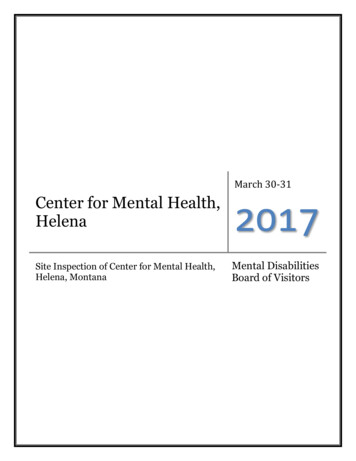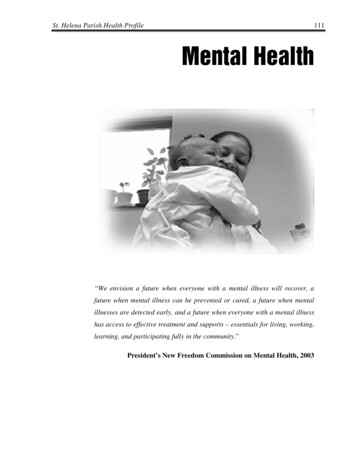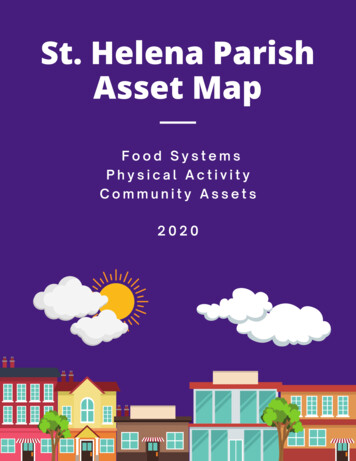
Transcription
Center for Mental Health,HelenaSite Inspection of Center for Mental Health,Helena, MontanaMarch 30-312017Mental DisabilitiesBoard of Visitors
OVERVIEWMental Health Facility reviewed:Center for Mental Health, Helena, MontanaMichelle Cuddy, Executive DirectorAuthority for review:Montana Code Annotated, 53-21-104 et seq.Purpose of review:1) To learn about services provided by Center for Mental Health, Helena2) To assess the degree to which the services provided are humane, consistent withprofessional standards, and incorporate Board of Visitors standards for services.3) To recognize excellent services.4) To make recommendations for improvement of services.5) To report to the Governor regarding the status of services.Site Review Team:Board:Consultant:Michelle Blair, BA PharmDBOV Staff:Daniel LaddLisa SwansonCraig FitchReview process: Interviews with staff and clients Observation of treatment activities Review written description of treatment programs Inspection of the physical plant Review treatment records, policies and procedures, organizational structure, allegationsof abuse/neglect-1-
IntroductionThe Center for Mental Health (CMH) in Helena provides mental health services toclients in the Helena and surrounding areas. These services include adult group homes,Program for Assertive Community Treatment (PACT), outpatient/group and familytherapy, adult drop-in center, day treatment, adult and youth case management, fostercare services, vocational services, and medication management services. The MentalDisabilities Board of Visitors (BOV) conducted a site inspection of the facilities inHelena on March 30-31, 2017.The BOV site inspection team was impressed with the attractive, well-keptadministration/outpatient buildings, homes and facilities. Each one was nicelylandscaped and welcoming with a space to relax. Homes were individualized andcomforting, and none felt institutional. Most staff were positive and enthused abouttheir programs and the services they provide. They expressed a genuine caring andconcern for the clients they serve.Organizational Planning and Quality ImprovementPlanning:CMH has a five-year vision plan that incorporates some long-term goals for theorganization. The more formal strategic plan appears to be done on a year by year basis.The one-year goals are broken down into quarters and have specific staffresponsibilities. Many of the quarterly goals have quantifiable expectations, but thereare a few that could benefit from a more measurable target.Quality Improvement:CMH has been steadily improving their QI capabilities over the past five years since thelast BOV site inspection. The center has a dedicated QA director that assembles dataacross the entire CMH service area. Data from individual regions can be analyzedindependently. Data includes bi-annual survey reports from clients.2
Rights, Responsibilities, and SafetyRights and Responsibilities:CMH does a good job of providing verbal and written information about rights to theclients and their families. Information is disseminated at the time of intake/admission.In addition, information regarding advocacy services is posted around the facilities andinformation regarding the Ombudsman/BOV is included within the information packet.CMH is following state guidelines for the grievance process and clients seemed awarethat a grievance process is available if they should want to use it. All staff could identifythe grievance process, but few knew how it worked or who was responsible for thedecision-making process.CMH has its own grievance procedure established in policy/procedure that is fair,responsive, and easy for clients and their family members to follow. The clients caneasily access the grievance form anywhere within the facility upon request. Clients signthese forms to indicate that they have reviewed and are familiar with them and a copy ofthis is placed in the client’s chart. Staff and clients were aware of the grievance formand the process although very few staff had ever fielded a complaint that utilized agrievance form. Interviewed clients indicated that if they had complaints or concerns,staff were available and responsive. Clients reported that they were satisfied with theresolutions of these complaints.Safety:Staff readily recited the requirements for mandatory reporting of suspected abuse orneglect of children or disabled persons under statute. Staff were less certain about theabuse and neglect requirements found in the statutes specific to mental health serviceproviders. In addition, some staff were unable to identify the person responsible forinvestigating allegations, although everyone readily identified that concerns are to bereported directly to their supervisor. Some of the confusion regarding the abuse/neglectinvestigation process was due to the fact that most staff had never had the need toreport any abuse or neglect concerns or been part of an investigation process.All staff are trained in C.P.I. de-escalation training and report feeling safe at work.Management investigates all reported incidents. CMH program does not use restraintsor other extraordinary behavior controls. Debriefings are provided as needed.-3-
Staff Competence, Training, Supervision andRelationships with IndividualsCompetence and Training:CMH policies define the optimum knowledge, qualifications and competenceexpectations for all personnel working with individuals with mental illness. In addition,CMH ensures that all staff are trained in a certified de-escalation program calledMANDT. Prior to starting work with CMH all employees start with an intensive 2 daytraining that includes administrative and clinical information. After the initial trainingsession staff are closely followed by supervisors as they learn all of the skills necessary tosucceed.CMH requires all personnel assisting clients with medication administration to betrained. These personnel are assessed on an annual basis by re-training to identify andaddress knowledge and competence deficiencies. All medication trained personnel wereaware of the education booklet and were able to reference it when asked. When asked bythe BOV team, some medication personnel were unsure the process around controlledsubstances and refrigerated medications.The Program Manager at each facility reviews each client’s medication record forappropriate administration of medications. Each month, the Program Manager reviewseach medication sheet and initials it to indicate completion of the review. The personnelappear to be satisfied with the level of supervision received.Active Engagement with Individuals:Clients at CMH had many positive things to say about the services and support theyreceive. They appeared to be satisfied with the services provided and reported feelingsafe in the day program. Clients also provided positive reports about their experiencesliving in the adult group homes and/or adult foster care/recovery homes. The staff waspresent around the facility and appeared to have good relationships with the clients.The staff interacted with the clients in a positive and calm manner.Treatment and SupportGeneral:All clients applying for services at CMH are asked to complete an intake packet thatincludes an intake screening form, medical history, an insurance information form,-4-
policies addressing aggressive behaviors, clients’ rights, and the grievance process. Theintake packet includes the crisis line number, with encouragement to use it if necessary.A clinical assessment is scheduled upon receipt of the completed intake packet. Duringthe clinical assessment, the clinician makes referrals to the program that could bestmeet the client’s needs. The clinician also completes the initial treatment plan within thefirst 20 days.Written treatment and discharge plans in the electronic medical record were identifiedin the select client charts that were reviewed. LIPs are responsible for ensuring thenotes were forwarded to a client’s primary care provider and that a complete physicaland medical examination had been completed. When a client is transferred to anotherlevel of care including the crisis center, hospital, inpatient psychiatric unit, statehospital, etc., the appropriate records are printed and sent with the client to insurecontinuity of care.Maybe the most impactful program BOV reviewed was the Program for AssertiveCommunity Treatment (PACT) serving clients currently living independently in thecommunity. At the time of the inspection, the PACT Team was serving 53 clients inHelena.The PACT team meets five days a week, Monday through Friday, for a check-in and thenmeet again from 12-1:30. The morning is a quick 15-minute meeting to see who’s onboard-to-do-what for the clients such as deliver medications, take people shopping, orwhatever is needed that day. The Team delivers medications to clients seven days aweek.Treatment Planning:Written treatment and discharge plans are in place for every individual client at CMH.Treatment plans are implemented and updated while the client is receiving services atCMH. CMH utilizes treatment panning to promote continuity of care and ensure clientshave access to an array of primary care services. This allows for a thorough physical andmedical examination at least once a year and proactively rules out medical conditionsthat may be responsible for presenting psychiatric symptoms.Trauma Informed Care- Evidence-Based ServicesCMH staff are trained in and utilize Trauma Informed Principles of care. The BOVnoted the concerted effort to include a Trauma Informed Care (TIC) approach to theirdaily activities such as: Using the Adverse Childhood Experience (ACE) questionnairefor consumers of services, increasing workforce knowledge and competence in TIC,-5-
conducting ongoing TIC education and training for all staff, and implementing TICpolicies/procedures and standards of practice.CMH continues to expand on their goal of utilizing TIC principles with clients who havebeen impacted by ACE’s and continue to learn, heal, grow, and make peace with the helpof Trauma Informed Care principles.Housing:The Helena area continues to have an abundance of adult foster care providers. CMHalso has a pair of adult group homes. Nonetheless, like most community mental healthproviders, CMH struggles with the ability to provide adequate housing options forclients. Staff and clients alike expressed a significant frustration at the extended lengthof stays that most clients experience at both foster care and group home placements.Apparently, most clients have no idea that they have the right to request assistance intransferring to independent living and it appears as if the prevailing culture at CMHHelena is one that fails to fully support independence as a primary component of therecovery process.Education and Employment:Most youth attend classes in area public schools. CMH has developed successfulrelationships with schools to allow their clients to remain in class and receive astructured, effective school setting.CMH is supportive of client’s employment opportunities. Case managers often workclosely with clients to help them find some type of meaningful employment. CMH hasDaily Living Skills trainings for clients to help them take more control of their own lives,with the goal of living more undependably.Co-Occurring Psychiatric and Substance Use Disorders:CMH does not provide segregated substance use disorder treatment, but often providesco-occurring treatment when appropriate. They provide co-occurring treatment in allphases of services throughout their services when appropriate. A client in need ofsegregated substance use disorder treatment is referred to outside communityresources. The State of Montana has dissimilar licensing requirements for mentalhealth and chemical dependency treatment programs, which is a barrier to providingeffective co-occurring treatment.-6-
Upon review of the electronic medical records, multiple patients were beingappropriately managed with medications for opioid use disorder and alcohol usedisorder along with a co-occurring psychiatric diagnosis. Medication AssistedTreatment at CMH appeared to follow the standard of care for management andmonitoring, however, no formal protocols were provided.Medications:Upon review of the medical records, prescribing at the Center for Mental Health appearsto be evidence-based and reflects internationally accepted medical standards. Rationalefor prescribing, changing, and tapering/titrating medication therapy as well asmedication therapy monitoring (i.e. labs, vitals, rating scales for response, etc.) wereconsistently documented in the electronic medical record (EMR). Metabolic monitoringwith antipsychotic medications based on American Psychiatric Association andAmerican Diabetes Association guidelines were also routinely documented in the EMR.Measures for medication management, monitoring, storage and dispensing ofmedications by medical staff are in the policies and procedures manual.Medication allergies, side effects, adverse reactions, and abnormal involuntarymovement disorders were documented in the EMR, closely monitored, and promptlytreated as appropriate. Monitoring for abnormal involuntary movements wasdocumented using the abnormal involuntary movement scale (AIMS) assessment on allclients taking an antipsychotic medication at baseline and every six months as orderedby the CMS psychiatrist.Medications are stored, transported, administered and reviewed by an authorizedperson consistent with laws and regulations. Medications that require refrigeration arestored in a refrigerator marked for medications only which is located in the office area.Temperature is recorded weekly by group home employees for quality control. Samplemedications are securely stored in a locked cabinet and are dispensed only at theinstruction of, and under supervision of the CMH psychiatrist by the nursing staff.Sample medications are periodically reviewed by nursing and outdated medications arediscarded. Medications, including samples, are always destroyed in the appropriatemanner and are never kept or used for other clients under any circumstances.Many clients pick up their own medications and take them independently as instructedor prescribed. Some clients benefit from the CMH medical staff setting up theirmedication boxes. If medication non-compliance is suspected, this additionalsupervision may be ordered by the CMH psychiatrist. Medication boxes are filled daily,weekly, or monthly depending on the client’s needs. Medication boxes are labeled withthe client’s name and include a list of medications and directions for use. The original-7-
medication bottle issued by the pharmacy is kept by CMH nursing staff in a secure,locked, dry location, with the original label in place. This excludes scheduledmedications. No controlled substances are stored on CMH premises or dispensed byCMH staff. Poor medication compliance is documented in the electronic medicalrecord. The CMH nursing staff promotes medication adherence through negotiationand education. Providers have open conversations with the clients and providemedication education to promote adherence.Education on specific medications prescribed to the patients are discussed by theproviders and nursing staff at each visit (i.e. indication, directions for use, expectedresults, adverse effects, monitoring, cost, and adherence). The nursing staff educatesclients about all medications, including those for medical comorbidities. All client andfamily questions were assessed and documented appropriately. Medication educationgroups are conducted by nursing students every semester approximately three times peryear, however, there were no other regularly scheduled medication education groups.Included in the policies and procedures is clear guidelines for how staff are to documentmedication errors. The medication error is recorded in the client’s chart by nursing staffand communicated as soon as possible to the CMH psychiatrist. A medication errorform is also filled out within 24-hours and reviewed once a month during IncidentReview with the medical director.Access and Entry and Continuity of Services ThroughTransitionsCMH has created an open access time on Thursday mornings to make it easier forpeople to sign up for services. Although, sometimes staff shortages are an issue and canextend the length of time before a prospective client can see some professionaldisciplines.The communication/collaboration between St. Peter’s Behavioral Health Unit, the localcrisis facility, the crisis response team members, and CMH in Helena is challenging attimes but is being addressed.Clients do have immediate access to therapists for initial clinical assessments. There is aslightly longer wait to see a case manager or medical provider. Following the initialassessment, the clinician makes referrals to programs that best meet the client’s needs.CMH has specified transition or continuity of care protocols for all transition services.Transitions within the community seem to be well-coordinated, especially transitions-8-
in/out of community crisis services (which are run by another provider who resides onCMH campus).OBSERVATIONS/RECOMMENDATIONS:1) Consider quarterly chart review conducted with the pharmacist to assess formedication appropriateness, effectiveness, safety, adherence, and properadministration techniques.2) Analyze the lengths of stay for clients at the adult foster home and adultgroup home placements and be more proactive in assisting clients who areready to transition to independent living.3) Consider joining with local hospitals to provide more continuing educationopportunities for staff, including Project ECHO.4) Utilize students (i.e. nursing, pharmacy, medical) from surrounding colleges tohelp provide more medication education groups on a regular basis.-9-
The Center for Mental Health (CMH) in Helena provides mental health services to clients in the Helena and surrounding areas. These services include adult group homes, Program for Assertive Community Treatment (PACT), outpatient/group and family therapy, adult drop-in center, day treatment, adult and youth case management, foster










